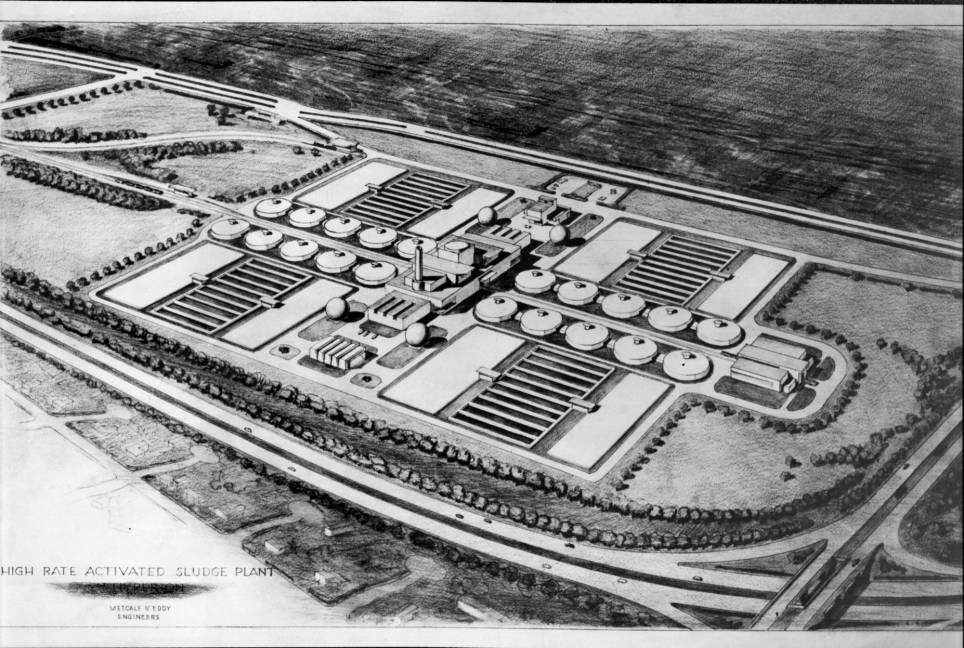
Post-War Planning, April 1944: concept drawing of a high-rate activated sludge treatment plant proposed to replace the City of Los Angeles Hyperion screening plants (drawing by Metcalf and Eddy, 1944) Source: USC Digital Library
The CWEA History Committee recently had the good fortune of acquiring a 1943 CSWA Annual Convention and Conference program from the estate of the late Roy E. Ramseier, consulting engineer and longtime member of CWEA. In 1943, Mr. Ramseier was serving as Senior Sanitary Engineer, Pacific Division of the U.S. Engineering Department and was actively involved in both the CSWA training and wartime training related to sewage treatment and disposal.
The 1943 Annual Conference program came with papers for each of the conference presentations and included a complete set of 1943 lecture papers prepared by Professor Charles Gilman Hyde used for Army training in sanitary engineering at U.C. Berkeley as part of the federal government’s “Engineering, Science, and Management War Training” course. This information allowed the CWEA History Committee to take a journey back in time 75 years to an Association Annual Convention and Conference during World War II.
The CWEA History Committee recently had the good fortune of acquiring a 1943 CSWA Annual Convention and Conference program from the estate of the late Roy E. Ramseier, consulting engineer and longtime member of CWEA. In 1943, Mr. Ramseier was serving as Senior Sanitary Engineer, Pacific Division of the U.S. Engineering Department and was actively involved in both the CSWA training and wartime training related to sewage treatment and disposal.
The 1943 Annual Conference program came with papers for each of the conference presentations and included a complete set of 1943 lecture papers prepared by Professor Charles Gilman Hyde used for Army training in sanitary engineering at U.C. Berkeley as part of the federal government’s “Engineering, Science, and Management War Training” course. This information allowed the CWEA History Committee to take a journey back in time 75 years to an Association Annual Convention and Conference during World War II.
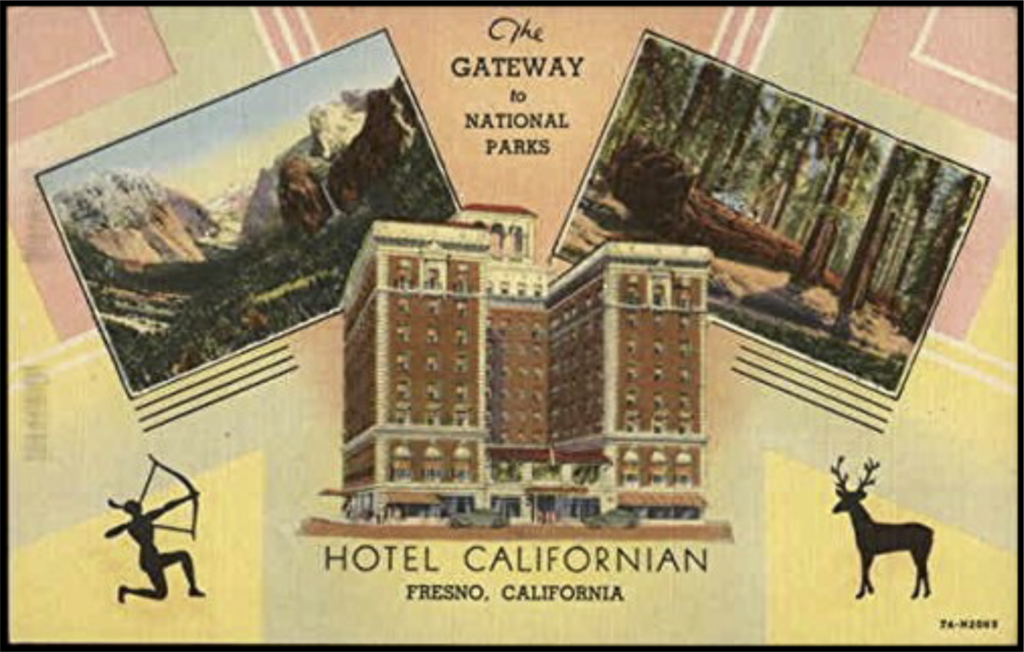
Advertisement for the 1943 CSWA Convention Site
The 1943 CSWA Annual Convention and War Conference was held in Fresno at the 258 room Hotel Californian. The Hotel Californian had a reputation as “being one of the city’s most exclusive venues. Travertine marble, Caen stone, oak flooring, crystal fixtures, concealed central air conditioning, and a pipe organ on the mezzanine level all contributed to critics’ claims of comparability with even the most luxurious hotels in the West. For over three decades, the Hotel California reigned as the largest, best-appointed and only “three-star” hotel between San Francisco and Los Angeles.”1 Fine dining and drinks were available for the CSWA Annual Convention attendees at the Hotel Californian’s “Bamboo Room”, which provided an exotic dining experience including bamboo separating the bar from the dining room.
The three-day Convention opened with the equivalent of the “icebreakers” held at current CWEA Annual Conferences. In 1943, the icebreaker consisted of an “informal smoker” and “get- together”. A “smoker” was the term for an informal social meeting and many of the conventions held by various associations in the early half of the 20th century started with a “smoker get- together” prior to the formal meetings.
Per the notes from the smoker, the meeting started at 8:00 and ended at 10:30 and “the attention of all present was focused at the buffet table on which was spread a plentiful supply of sandwiches, salad, relishes, beer, and soft drinks. These refreshments were furnished through the courtesy of five manufacturers whose representatives are members of the Association.”
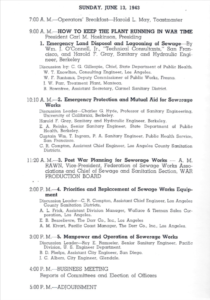
It is interesting to note, that the CSWA adhered to its mission of education during the smoker by including a film on water provided by the California Department of Public Health. The film was described as an excellent presentation of the history and need for water and sewage treatment.
As one might guess, the 1943 program included one full day of training on wartime related topics (the training for the other days consisted of standard O&M topics). The presenters on wartime topics were an “all-star” cast of CSWA leaders. Notables included Professor Charles Gilman Hyde (the “Dean of Sanitary Engineering in the West” and prominent consultant), A M Rawn2 (CSWA Past President and President of the Federation), Ed Reinke (Past President and CSWA’s first Secretary-Treasurer), and Harold F. Gray (Past President). All the aforementioned presenters were charter or founding members of CSWA, along with presenters A.M. Kivari and W.T. Knowlton.
Of interest to the CSWA Annual Convention attendees were the presentations on the “Priorities and Replacement of Sewage Works Equipment”. This “hot topic” centered on the War Production Board (WPB) requirements for making determinations related to the acquisition of materials and supplies for the maintenance of sewage collection and treatment facilities. The various WPB forms and procedures, along with budgeting, for the acquisition of needed materials were covered by this training session.
The WPB was an agency of the United States government that supervised war production during World War II. The WPB directed the conversion of industries from peacetime work to war needs, allocated scarce materials, established priorities in the distribution of materials and services, and prohibited nonessential production. It rationed such commodities as gasoline, heating oil, metals, rubber, paper, and plastics.3
Per the WPB requirements, steel, copper and aluminum were controlled materials, as were chemicals and other materials necessary for the operation and maintenance of sewage collection, treatment and disposal facilities. The WPB also curtailed the manufacturing of sewage equipment for both treatment plants and collection systems.
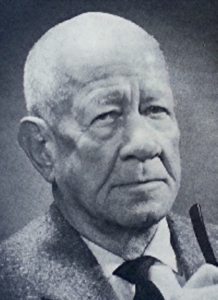
CSWA Past President and Federation President A M Rawn
Federation President A M Rawn was called upon by President Franklin Roosevelt to serve as ex-officio chief of the sewage and sanitation branch of the WPB. A M Rawn helped to establish the definitions and prioritization of what was “essential” for maintenance and the continuation of sewage services during the war. Rawn was instrumental in helping to simplify the procedures for acquiring materials and supplies by sewage agencies and he assisted in producing a pamphlet entitled “Bulletin 2” to help utility personnel understand the forms and procedures required by the WPB. Under A M Rawn’s leadership, the Federation mailed copies of “Bulletin 2” to member agencies to help spread the word.
The limitations on materials produced some interesting alternatives for wastewater collection system maintenance and storm system construction. The following photos provide examples of the use wooden manhole covers and wooden pipes that demonstrate how far agencies went to comply with WPB requirements and conserve metal needed for the war effort.
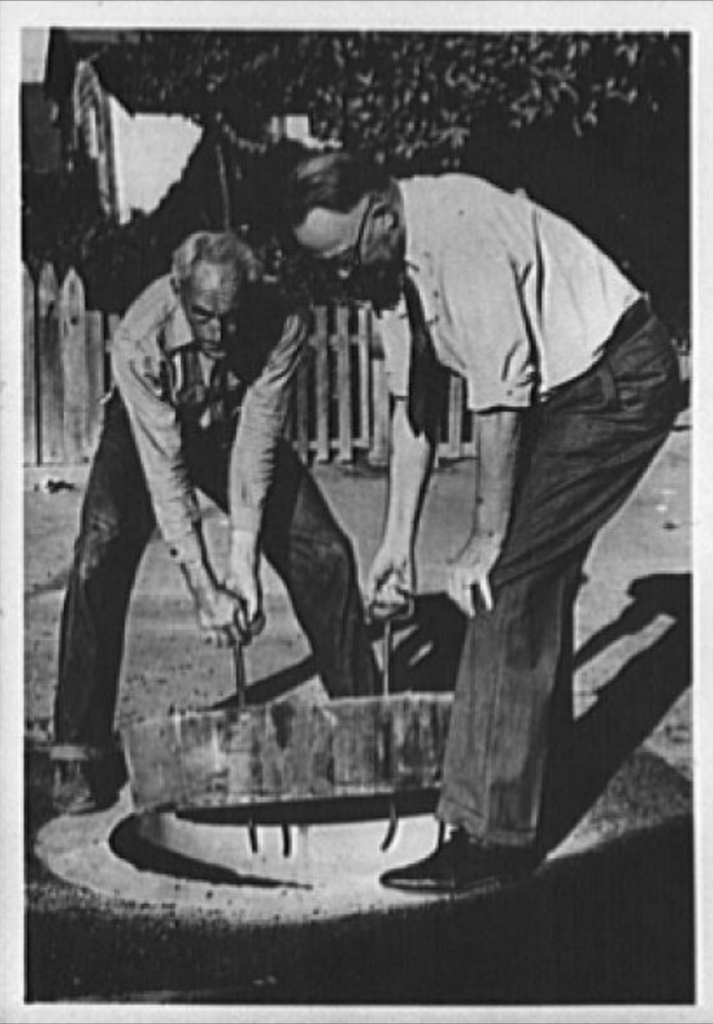
Lifting a wooden manhole cover into place is Colonel Carl H. Reeves, superintendent of the Los Angeles County, California, Maintenance Department. Treated to resist termites and decay, covers may be manufactured without the use of extensive fabricating equipment. A War Production Board (WPB) order prohibits the use of iron and steel for manhole covers (Source: Library of Congress).
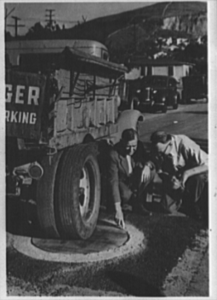
Strength of the wooden manhole covers installed in Los Angeles County, California, is pointed out to Colonel Carl H. Reeves, superintendent of the Los Angeles County, California, Maintenance Department, by Alfred Jones, county surveyor, 1942 (Source: Library of Congress).
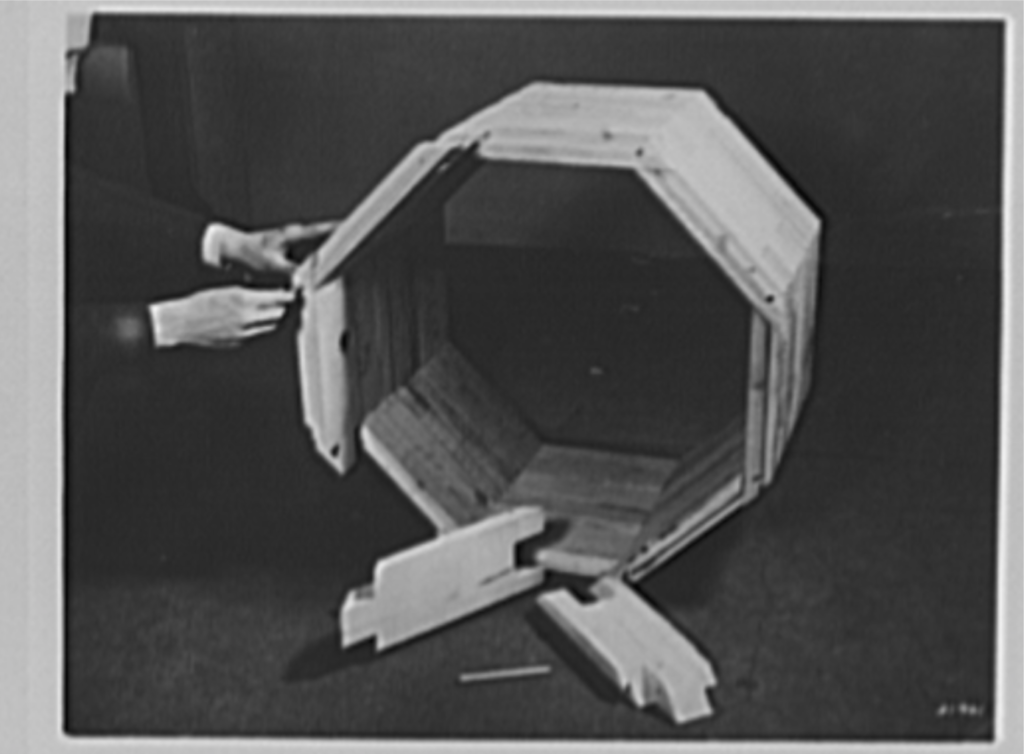
1942 – A wooden pipe used in place of corrugated metal pipe and concrete pipe. These pipes are made of sections cut from short lengths of wood. Locking of adjacent rings with hardwood dowel pins produces a flexible structure (Source: Library of Congress)
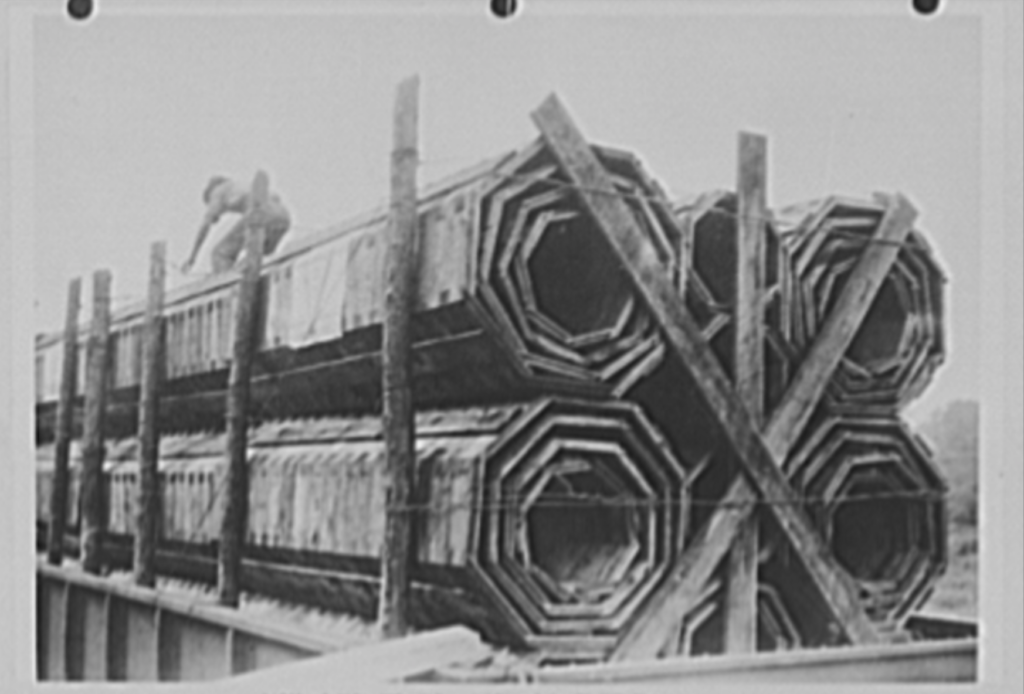
A shipment of 1,488 feet of 18-inch, 24-inch, 30-inch and 36-inch wooden pipe on one flat car. Weight 70,020 pounds. An equal footage of reinforced concrete pipe weighs 455,412 pounds, requires over ten cars. About 100,000 feet of these wooden pipes were installed in 1942 in drainage culverts, storm sewers and conduits, under highways and at army camps, naval stations, airfields and ordnance plants
Another hot topic during the 1943 annual conference was A M Rawn’s presentation on post-war planning for sewage works. Expansion and improvement projects were, for the most part, put “on-hold” during the war unless they were needed to serve military facilities and industries. By 1943, discussions of post-war expansions and system improvements had started, leading to the “Blueprint Now!” program promoted by the Federation and other utility organizations. With predictions of eventual victory, the “Blueprint Now!” program recognized the need for advanced planning to account for the backlog of deferred maintenance, system expansions and delayed improvements. Interestingly, the “Blueprint Now!” program emphasized financing post-war facilities with local funds as it was anticipated that federal funds would not be available at the end of the war.
Labor was an issue due to men joining and being drafted into the military and this topic was addressed by the last session at the 1943 Annual Conference. Military service put a drain on the pool of available “manpower” needed for the design, operation, and maintenance of sewage facilities.
An example of the impact could be seen in the decline of Association membership. In December 1941, the total active CSWA membership was 290. By the 1943 Annual Convention, 47 members (about 16 percent of the active membership), had left the Association for military service. What was notable about the wartime discussion of labor needs was the introduction of the topic of women becoming operators of treatment plants – which, based on a review of the records, was a first for our Association!
The CSWA Annual Convention Banquet was held on Saturday night in the Hotel’s second floor ballroom, which opened onto a “garden balcony”. One hundred and twenty-three members and guests attended the annual banquet. Guest speakers for the evening were Dr. Wilton. L. Halverson, Director, Department of Public Health for the State of California, and Homer Buckley, State Director of Civilian Protection. Other guests at the head table were Charles Gilman Hyde, University of California; Edward A. Reinke, Senior Sanitary Engineer for the State Health Department, Dr. William F. Stein, Fresno County Health Officer, and all the Association’s officers and directors.
After dinner, Dr. Wilton L. Halverson was introduced by CSWA President Hoskinson and presented a very timely and interesting address on the subject “Tropical Diseases and War” (what an appetizing dinner topic!).
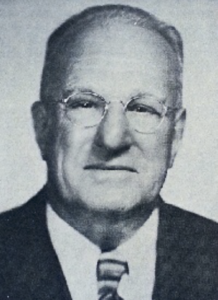
Professor Charles Gilman Hyde
The CSWA Governing Board Business Meeting was held at the end of the Annual Convention. Charles Gilman Hyde: President Hoskinson announced that the Governing Board had received a petition signed by thirty-four members requesting that the Board nominate Charles Gilman Hyde for Honorary Membership (lifetime membership) in the Federation of Sewage Works Associations for his numerous contributions to our field. The Board had previously approved this petition and authorized CSWA Past President William A. Allen, California’s representative on the Federation Board of Control, to make the nomination at the appropriate time.
It’s worth noting that the the four-week Army “Engineering, Science, and Management War Training” (E.S.M.W.T.) course led by Professor Hyde at U.C. Berkley overlapped with the 1943 CSWA Convention. Thanks to Professor Hyde and Roy Ramseier’s planning, the CSWA Convention was made part of the E.S.M.W.T. course allowing 22 of the E.S.M.W.T. students attend the Convention and receive credit for sewage treatment and disposal training.
The CWEA History Committee hopes you enjoyed this brief glimpse of the highlights of our 1943 Annual Convention and War Conference and, in closing, we offer this example of vintage CSWA “sewer humor” from 1943.
1 http://historicfresno.org/nrhp/californ.htm
2 Throughout his life, A M Rawn was plagued by eagle-eyed editors and proofreaders who insisted on “correcting” his name by punching a period after each letter A and M. The correct rendering of his name is simply “A M” with no periods.
3 Source: Wikipedia